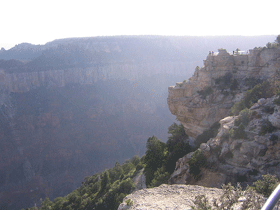July 3, 2009
Air Date: July 3, 2009
FULL SHOW
SEGMENTS
Cap On Trade
View the page for this story
Cap and trade isn't the only novel economic policy in the climate change bill that's headed for the Senate. A last minute addition to the Clean Energy and Security Act calls for mandatory "carbon tariffs" on imports from countries that won't commit to significant greenhouse gas cuts. While some argue the provision will help keep jobs at home and reduce emissions abroad, others say the fees would complicate U.S. efforts to negotiate an international treaty to address climate change. Host Jeff Young talks with George Washington University law professor Steve Charnovitz about what's at stake. (06:30)
Green Light on Energy Standards
View the page for this story
Seven percent of all energy consumed in the United States is for lighting. Now, President Obama and Energy Secretary Steven Chu have announced new standards for lightbulbs that will promote energy efficiency and cut carbon dioxide emissions by more than 590 million tons a year. Host Steve Curwood talks with Kateri Callahan, president of The Alliance to Save Energy, about the new standards and how Americans will be able to meet these goals. (05:30)
Raze to Save
View the page for this story
Flint, Michigan is in trouble. Half the population has skipped town and the remaining residents are surrounded by decrepit, empty homes. Now the town has a solution to fight the blight - bulldoze the dead parts and consolidate the living. Genesee County Treasurer Dan Kildee tells host Steve Curwood how this plan will save Flint and other depressed cities across America. (08:00)
Bad Air in a Big Canyon
/ Laurel MoralesView the page for this story
Cement plants are big air polluters and the Environmental Protection Agency is in the process of tightening its regulations on plant emissions. These new rules are coming just as cement giant Cemex wants to build a new plant in Arizona that would create jobs but also potentially cloud the view of the Grand Canyon. Arizona Public Radio’s Laurel Morales reports. (05:30)
Another Century of Great Lakes
View the page for this story
America and Canada have shared the benefits and responsibilities of the Great Lakes for a century. Now the international agreement that keeps both sides in check is getting an update. Dr. John Gannon is a senior scientist at the International Joint Commission. He tells host Jeff Young what the new agreement might look like for the next 100 years. (04:25)
Note on Emerging Science
/ Annie GlausserView the page for this story
A new device can pull drinking water out of humid air. Living on Earth’s Annie Glausser reports. (01:40)
Duck-Scrubbing Heroes
View the page for this story
The Coast Guard tackles everything from dangerous rescue missions to nasty oil spill clean-ups, earning guardsmen the playful nickname "duck scrubbers." But ocean conservationist David Helvarg says the Coast Guard's environmental duties are vastly important to marine life and underappreciated in the U.S. military. Helvarg talks with host Jeff Young about his new book, "Rescue Warriors: The U.S. Coast Guard: America's Forgotten Heroes." (08:00)
Bird Lovers Build Bird Database
View the page for this story
Ken Pauley is an avid birdwatcher. Now his love of birds is keeping him indoors. Pauley is one of numerous volunteers who are sorting through six million handwritten cards documenting bird sightings between 1880 and 1970 and transferring the information into a computer database. As Amy Mayer reports, the information could help researchers’ efforts to find out more about bird migration and the effects of climate change. (06:00)
This week's EarthEar selection
listen /
download
It's hammer-time for the American Three-toed woodpecker.
Show Credits and Funders
Show Transcript
Host: Steve Curwood and Jeff Young
Guests: Kateri Callahan, Steve Charnovitz, John Gannon, David Helvarg, Dan Kildee
Reporters: Amy Mayer, Laurel Morales
Science Note: Annie Glausser
[THEME]
CURWOOD: From Public Radio International - this is Living on Earth.
[THEME]
CURWOOD: I’m Steve Curwood.
YOUNG: And I’m Jeff Young. The House passes an historic climate change bill – but it has a bitter pill for developing countries to swallow – a carbon tariff. Experts say that could derail an international agreement.
CHARNOVITZ: We're a lot less powerful than we used to be and China's getting more powerful by the year and it's a fruitless strategy for us to think we can continue leading the world by threatening other countries.
YOUNG: Protecting jobs - and the climate.
CURWOOD: Also - saving dying cities by bulldozing the run-down parts. It’s the idea of the county treasurer for Flint, Michigan’s. He says residents have two choices.
KILDEE: Stay where you are and be surrounded by something more beautiful or take that value that you have invested in your property and transfer it into a neighborhood that looks a lot more like the neighborhood maybe that you grew up in.
CURWOOD: Greening the rust belt - and more - this week on Living on Earth! Stick around.
Cap On Trade
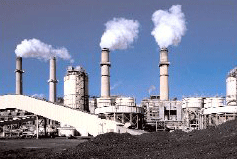
The United States emits five times as much C02 per capita as China, though the quickly-developing nation recently became the world's largest source of greenhouse gases. (Courtesy of the EPA)
CURWOOD: From the Jennifer and Ted Stanley studios in Somerville, Massachusetts, this is Living on Earth. I’m Steve Curwood.
YOUNG: And I’m Jeff Young.
The U.S. Senate will soon start work on the historic global warming bill that narrowly passed the House of Representatives. Democratic leaders say they hope action in Congress will improve the odds of getting a climate change treaty later this year.

Congressmen Henry Waxman (left) and Ed Markey (right) passed the first legislation that would limit the country’s heat-trapping pollutants.
GERARD: The is about making sure that as we move to the green economy that we’re not putting our jobs up for bid to China where for every unit of production they create one, two, three or four times as much carbon. And we're not going to be a part of giving away our economic future.
YOUNG: The tariff wouldn’t kick in until 2020, but still, President Barack Obama calls it Protectionism, and wants it out of the climate bill. And China’s Department of Climate Change Director, Li Gao, warns carbon tariffs would violate world trade rules and could
spark a trade war.
LI GAO: If developed countries set barriers, in the name of climate change set barriers for trade I think it’s a disaster. It’s not fair.
YOUNG: Associate Professor Steve Charnovitz studies the links between trade and the environment at George Washington University’s law school, and he’s with us now. Professor Charnovitz says the Chinese official makes a good point.
CHARNOVITZ: It’s not fair for a lot of reasons. It’s not fair to Americans because it was written a few hours before the House passed the bill and no one had time to see it. And internationally I think it’s unfair because the United States unilaterally prescribes a certain formula that other countries have to meet. You know, there’s a multilateral process in the climate negotiations that’s been going on since 1992 to devise an international agreement to deal with climate. And for, you know, most of the last eight years, the United States was not a productive part of that process. So for us to come in--in 2009 and start threatening other countries I think is unfair.
YOUNG: So what might this mean for the efforts to craft some international agreement that would necessarily have to bring in the Chinas, the India’s, the Brazils of the world.
CHARNOVITZ: Well it’s not going to be helpful – I think getting them to cooperate is going to be hard in any event. But, if we’re threatening trade measures against them that are unilaterally prescribed simply by the United States, then I think it makes it much harder.
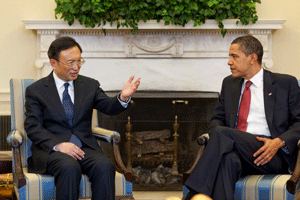
The President in a meeting with Chinese Foreign Minister Yang Jiechi in March. (Courtesy of the White House)
CHARNOVITZ: Well that’s a legitimate concern. If some countries don’t participate in reducing greenhouse gases, then those like the United States that do participate will have higher costs and that will lead to some disadvantage in particular industries. But, it’s not clear what the overall impact of the bill is gonna be on the U.S. economy. I don’t know if I’d call it a trade war, but it could also lead to other countries doing the exact same thing. I mean, they could pass bills like the Waxman bill applying to U.S. imports based on their own idiosyncratic formulas for what they consider to be appropriate action by the United States.
YOUNG: Well, the President has spoken out against this trade aspect of the bill, while endorsing much of the rest of the bill. Now the Senate’s going to take whack at things. Where do you think things are headed here with climate change and free trade?
CHARNOVITZ: I would guess the Senate, if they’re able to pass the bill, it will contain some trade measure. The bill the Senate was considering last year, the so-called Lieberman-Warner bill did have trade measures. So I think that’s probably part of the formula. But it’s possible they would water down the House bill. The way the bill was written the President is really mandated to take these trade measures and that would be challengeable in the World Trade Organization, that is, China could bring a lawsuit against the United States.
YOUNG: And what do you think the World Trade Organization might rule if this case were brought.
CHARNOVITZ: I think it’s clear the bill violates the general agreement on tariffs and trade, and if the United States were to claim a defense under the environment exception, that defense by the United States would fail, because the way it’s written by the House, it’s aimed at promoting a level playing field, and trying to level producer costs is not a legitimate grounds for invoking the environment exception in the World Trade Organization. So the smart approach is to try to negotiate with China on not only on getting them within the system, which we’ve been doing of course, but also on questions of how are we going to deal with competitiveness problems with countries that don’t participate.
YOUNG: Does it not help though to negotiate softly but have that big stick of the carbon tariff if they don’t get on board?

(Courtesy of the EPA)
YOUNG: So this might be an appropriate tool to have in the toolbox, but it’s not the one you should pull out at the first.
CHARNOVITZ: Absolutely, we should not. The United States has a long history of threatening unilateral measures against other countries that don’t conform to what we think they should do. And the United States got away with it for a long time, because we were the most powerful country economically in the world. But we’re a lot less powerful than we used to be. And China’s getting more powerful by the year. And in order for climate change to be addressed, you’ve gotta have cooperation of all the major emitters. It’s a global environmental problem and if it’s gonna be solved, it’s gonna require a global environmental solution.
YOUNG: Professor Steve Charnovitz researches the links between trade and the environment as part of his work at the George Washington University Law School. Thanks very much for joining us.
CHARNOVITZ: Okay, thank you very much.
[MUSIC: Erik Truffaz “The Mask” from The Mask (Blue Note records 2000)]
Related links:
- For a different take on “carbon tariffs,” check out Nobel-Prize-winning columnist Paul Krugman’s blog.
- For more on Steve Charnovitz, click here.
- For more on the Clean Energy and Security Act, click here.
- Read the President’s reaction to the Waxman-Markey bill here.
Green Light on Energy Standards

The common light bulb is so inefficient that it generates more heat than light.
CURWOOD: According to Energy Secretary Steven Chu, "When it comes to saving money and growing our economy, energy efficiency isn't just low-hanging fruit, it's fruit lying on the ground.”

Energy Secretary Steven Chu. (Courtesy of Lawrence Berkely National Laboratory)
CALLAHAN: Hi Steve, how are you?
CURWOOD: Good. President Obama and his energy secretary Steven Chu have now announced new lighting standards that some are saying this is the U.S.’s greatest push toward saving electricity. How pleased are you with these standards?
CALLAHAN: We’re delighted. This is yet another marker in a march toward a clean energy future that the President announced he was going to take us on and, by golly, he’s doing it. It’s really interesting when you think about little light bulbs, you know, I liken it to the David and Goliath. I mean, they look small, how much energy could you really save? And it turns out that what the President announced yesterday will be the largest energy savings standard that any administration has ever put forward. These standards – once they go into effect in 2012 – within thirty years, we will save enough energy and enough greenhouse gases that are the equivalent of taking 166 million cars off the road, according to the President. So that’s a profound impact on our energy use.
CURWOOD: Now, how much further could they have gone in setting these standards?
CALLAHAN: They could have gone further. There were some studies done – technical studies – they could have moved to more efficient bulbs than they did. But I gotta tell you Steve, this is pretty darn good. The standards apply to two different categories of light bulbs: one are florescent tube lighting that you see commonly in offices and stores. And factories. And the improvement – they’re moving from what they call a T12 tube, which is basically they’re going from and inch and a half round tube down to an inch round tube. Those smaller fluorescents saves about fifteen percent on energy compared to the larger. And the other category is what they call incandescent reflector lamps or IRLs and these are commonly what you see in recessed lighting or some people call it canned lighting and track lighting. And for those there’s gonna be a twenty five percent improvement in the energy efficiency. So, it’s pretty significant.
CURWOOD: Looking over this rule making, this doesn’t go into effect until 2012, that’s what two and a half years from now. What about getting this into place sooner?
CALLAHAN: Well, the light bulbs are available now, Steve, and the issue with standards and having them delayed from the time they’re announced from the time they actually take effect is to allow the manufacturers to scale up production or those who may not be producing the more efficient products to be able to tool up to produce those and also to allow for time for stock to be used for people that have, you know, stock piled some of these things and to get them out of the market system. So it’s very, very typical that there’s a delay in the start of standards so that people can get ready for them.
CURWOOD: So how do you enforce something like this? I mean, I’m wondering if one creates a light bulb police here? I mean, I could use a light bulb police in my house but only for those who snatch the light bulbs – the light doesn’t go on.
CALLAHAN: It won’t be enforced on consumers. No one’s going to come into your house and look at what kind of lights you have. It really is all about getting them out of the marketplace so you don’t have the opportunity to buy them. And so, when you burn out – let me assume for a minute you’ve got some track lighting in your den – when those track lights burn out, if they burn out after 2012, you will no longer be able to choose the most inefficient products that you could today. You’re probably still likely to have choices. There will be more and less efficient bulbs, but they’ll meet a minimum efficiency standard. So that’s the way it’s imposed upon the manufacturers and they’re just simply not allowed to sell the products that don’t meet those standards.
CURWOOD: What about the mercury that’s in compact fluorescent bulbs?
CALLAHAN: Right. Well, there are standards for that that have to be met, and the good news is that the mercury levels in light bulbs that are being produced is actually going down. And it is an issue, but it is one that can be dealt with. The EPA has guidelines about how to properly dispose of CFLs, because they do have some mercury in them, how to clean up after an accident where a CFL breaks. It is an issue. Is it a showstopper? Certainly not. And the interesting thing is that there is more mercury – airborne mercury – that goes into the air from the power plants that are providing electricity to incandescent bulbs – far more – than there is in the CFLs that are using the electricity.
CURWOOD: Kateri Callahan thank you so much.
CALLAHAN: Thank you, Steve.
CURWOOD: Kateri Callahan is President of The Alliance to Save Energy. And for more information on the new light bulb standards, go to our website, loe.org.
[MUSIC: Lal Meri “Give Me Your Light” from Lal Meri (Six Degrees records 2009)]
CURWOOD: Coming up: destroying part of the village in order to save the rest of it – can smart bulldozing make Flint, Michigan better? Keep listening to Living on Earth.
Related links:
- Read the President’s announcement of the new standards.
- The Alliance to Save Energy
- Energy Star
[MUSIC: Andy Narell & Relator: Pan In Harmony from University Of Calypso (Heads Up Records 2009)]
Raze to Save
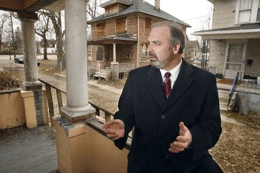
Dan Kildee visits one of Flint’s many underpopulated neighborhoods.
YOUNG: It’s Living on Earth, I’m Jeff Young.
CURWOOD: And I’m Steve Curwood.
Bigger no longer means better -- at least not for Flint, Michigan. What was a thriving city in the heyday of General Motors is now torn by severe unemployment and abandoned houses. Flint’s population is now half of what it was, and more and more people pack up and leave every day.
With the tax base melting like ice on a hot summer day, Dan Kildee, a lifelong city resident who also is county treasurer, came up with a novel idea - how about organizing the downsizing of Flint in ways that revitalize and green the community? He’s on the line now, so Dan, please, can you take us first for a virtual walk around the North End of Flint—what would we see?
KILDEE: What you’d see is you’d see pockets of really strong neighborhoods—you know, four, five houses or even three or four blocks, maybe five blocks in a row, where everybody’s doing their best and they’re trying and they’re keeping their neighborhood together, and then you’ll run into a street with one or two houses occupied, and maybe four, five or eight or ten abandoned houses, and then a bunch of abandoned lots in between.
And there doesn’t seem to be any real order to it. And so the problem is, the people who live close to that abandonment, they have a life that just isn’t—it’s not fair to them. It’s not fair that they’ve invested their lives and their money in their house, and because of things well beyond their control, they’re surrounded now, really by a lot of ugly property. So that’s really what we’re trying to get at.
CURWOOD: So, how do you win over residents? If you look there, at the North End—the North Side of Flint, this is largely a community of color. And you folks who are talking about this, are largely the white governing structure. How have they gotten involved in this planning process today?
KILDEE: When I first started thinking about this, I was a little worried about mentioning this idea of planned shrinkage in certain areas. Let me tell you—the people who live in the neighborhood, they’re way ahead of us. They know it’s more about helping them on their own street, in their own neighborhood. There’s gotta be a high degree of public participation, in a very public planning process, that leads to this ultimate design. That’s one.
Second: not one person should ever lose their house if they don’t want to. One hundred percent voluntary is the only way this can work. So I want them to have a choice: stay where you are and be surrounded by something more beautiful, but it’s a low density environment, it’s not the urban environment or take that value that you have invested in your property and transfer it into a neighborhood that we can sustain, that looks a lot more like the neighborhood maybe that you grew up in.
CURWOOD: I want to visualize this. I mean, if you knock down a house, it just makes a vacant lot. What do you do to rehabilitate this land to make it more attractive?
KILDEE: Well we have a number of things we do. In some cases we simply let the land go back to nature. Nature does wonderful things, takes something that’s ugly and turns it into natural beauty. Sometimes nature needs a little help though. And in those cases we can bring in wildflower seeds, we can bring in trees, we can actually engage the neighbors.
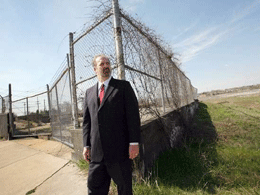
The bulldozed areas will be returned to nature.
CURWOOD: So most of the time cities reclaim vacant land and they do so to develop on. So you’re doing un-development, huh? Some might think that’s backwards.
KILDEE: Well, you know, I think one of the things that is not well understood is that because a city is becoming smaller does not mean we don’t do new development. One of the things that surprises people most when they hear our story, is to learn that right in our downtown, in the center of Flint which had been forgotten essentially, you know, almost a ghost town for a while.
Just in the last year we’ve had a $100,000,000 of new construction. It’s not so much that we don’t do development, but we do development with an aim toward creating a much more compact and sustainable downtown, and then a much more carefully designed collection of neighborhoods that no matter what happens in ten or fifteen or twenty years, we can still count on those neighborhoods being there.
CURWOOD: So as I understand it, tearing down abandoned buildings in Flint isn’t especially new. Tell me about the Land Bank?

Dan Kildee visits one of Flint’s many underpopulated neighborhoods.
CURWOOD: Where does the money come from?
KILDEE: The money interestingly enough comes from the very same process that used to enrich those infomercial-watching speculators. You know, if you stay up too late at night and watch television you can see these odd infomercials that explain how to invest in these tax sale properties.
CURWOOD: Oh yes “You can make millions of dollars with turned over foreclosed property from the government.”
KILDEE: [laughing] Exactly.
CURWOOD: “Here’s a list. Just call this number now”
KILDEE: Exactly. I go to Wall Street every year. I borrow the money that is owed from all those delinquent taxpayers, give it to all the local governments and then I collect that high rate of interest that people pay for their delinquent taxes. I borrow money at three percent. I collect it at eighteen percent. The spread gives me money to invest in rehabilitation and the houses that we can rehabilitate.
CURWOOD: So you started this Land Bank seven years ago. What’s new about what you’re proposing now?
KILDEE: Its really the strong need for a new master plan. If we had a new design for our city that acknowledges that we’re smaller, then when we acquire property, we know where we should demolish, were we should rehabilitate, where the gardens should go, where the new meadow should be, where streets should be rebuilt or perhaps where they should be allowed to go back to nature. It would allow us to be much more wise and much more careful about how we make investment.
CURWOOD: Who else could benefit from this?
KILDEE: Well, I think virtually every city could, but the smart cities that will use these tools are the cities that only have a little bit of worry about this kind of decline that we’re facing. So I encourage cities that are not facing wholesale decline to think differently about their urban landscape and don’t sit on the sidelines. Get in the game. Get control of those few blighted properties at the earliest point to prevent contagious blight which like any, you know, sort of unchecked disease can wipe out whole neighborhoods in just a decade.
And I make that point by saying this: If somebody would have, you know, sort have sat down the leaders of Flint thirty five years ago and told them what would happen if we just sort of sat on the sidelines and let things run their course, we probably would have come up with this very same tool that we’ve developed. And it would have worked better. It would have been a lot easier.
CURWOOD: Dan Kildee is the Genesee County treasurer and Land Bank chairmen in Flint, Michigan. Thanks so much, Dan.
KILDEE: Thank you very much. I enjoyed it.
[MUSIC: Jake Shimabukuro “Thriller” from Live (Hitchike Records 2009)]
Related link:
To read more about Flint’s plans, click here.
Bad Air in a Big Canyon
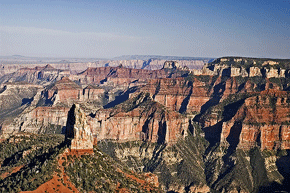
The North Rim of the Grand Canyon.
YOUNG: The Environmental Protection Agency plans to firm up its rules on cement plants. Cement kilns pump dust and soot into the air along with toxic emissions like mercury. EPA's regulations come just as cement giant Cemex hopes to start up a new kiln in Arizona.
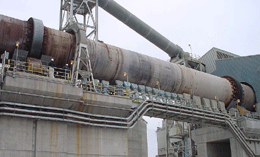
A medium-sized modern cement kiln.
[CHIRPING OF THE METER]
MORALES: For eighteen years it’s been Carl Bowman’s job to guard the 100-mile view at Grand Canyon. He leans over what looks like a large telescope to check the day’s visibility on an air monitor.
BOWMAN: On our very best days you know those days that just take your breath away you walk up to the rim, you look across, the North Rim’s ten miles away, and the colors over there are bright. The shadows and textures are nice and crisp.
[TOURIST CHATTER]
MORALES: Nearby, tourists pose for pictures at the popular overlook and take in the glorious crags, cliffs and brilliant red rocks in every hue.
BOWMAN: It feels almost like you can reach out and touch it. But as the haze starts to build up the colors start to get muted, the textures start to kind of flatten out. On those haziest days you can look across and see the North Rim but what you’re seeing is just this looming blue mass on the other side of the canyon.
MORALES: Whether wind direction and smog blown in from as far away as Los Angeles and Mexico can each affect the view.Bowman says the view has noticeably improved over the last two decades thanks to the Clean Air Act. The law forced two power plants that flanked the Canyon to make big changes. One installed expensive scrubbers; the other closed.
But the proposed cement plant could be a step backwards.
BOWMAN: Any time there’s a proposal for a new facility close to the park, of course we’re concerned, because when we look at the pollution problems that we see within the park, we find that most of them are caused by air pollutants that are actually generated upwind from us.
MORALES: Cemex spokeswoman Jennifer Borgen says the company plans to build an environmentally friendly plant. And she points out federal law protects air quality at national parks.
BORGEN: It’s plain and simple the plant will need to meet the strictest emissions requirements ever written and enforced by the state and federal agencies because it’s close to the Grand Canyon. If it cannot, it will not receive the permit or not be allowed to operate. It’s that simple.
MORALES: Cemex plans to burn coal and petroleum coke to fuel the plant. Coke is a byproduct of oil refining that looks like asphalt run through a coffee grinder.
Cement plants also cook limestone in kilns five times hotter than pizza ovens. Each step can emit pollutants, especially nitrogen oxide, sulfur dioxide and particles.
Northern Arizona University environmental engineer Bill Auberle spends a lot of his time monitoring the air quality at Grand Canyon. He says Cemex needs to provide the details.AUBERLE: My concern is this, that the Clean Air Act of the United States says that no man-made air pollution shall impair visibility at the Grand Canyon National Park and other parks. Zero! We’re not to be fouling the air at Grand Canyon.
MORALES: And Auberle points out Cemex has a history of running afoul with the Environmental Protection Agency. Most recently the company agreed to pay two million dollars to resolve complaints in California.
AUBERLE: Cemex does not have a strong environmental track record. They talk about sustainability and their commitment to a greener environment. But it will take all of that and perhaps more to own and operate a Portland cement plant as they have proposed it.
MORALES: The technology does exist to build a clean cement plant but it’s expensive. And the industry isn’t flush right now. Cemex’s sales are down 40 percent compared to last year. If the EPA requires retrofitting, that will be expensive. But Cemex’s Jennifer Borgen says the company is both bullish on the business and committed to a clean facility.
BORGEN: We know that the economy’s going to come back. We know it’s going to bounce back and demand before the recession started in Arizona was very robust. Cement had to be imported into the state—whether it’s road building or home building or road repairs or bridge repairs.
MORALES: Politics have shifted in Arizona since Governor Janet Napolitano went to work for the Obama administration as Homeland Security Chief. A new environmental director and governor want to attract more industry and jobs to the state. And Arizona lawmakers want fewer environmental restrictions.

The North Rim of the Grand Canyon.
BOWMAN: It says that we will protect the resources within the national parks from damage caused by air pollution. But the Clean Air Act gives us virtually no authority to do anything about air pollution. Instead the act gives that authority to the states and the tribes.
MORALES: So he says working with the state will be critical to protecting the air at the park.
Cemex is now seeking its permit. Once the company files a formal plan, a team of national park specialists will be able to model possible effects. Then state and federal officials will decide whether Cemex can build.
For Living on Earth I’m Laurel Morales at Grand Canyon.
[MUSIC: Slim Gaillard “Cement Mixer” from The Legendary McVouty (Hep Records, Reissue 2000)]
Related links:
- Air Quality in the Grand Canyon
- Cement Maker CEMEX
- Cement Makers Trade Association
Another Century of Great Lakes
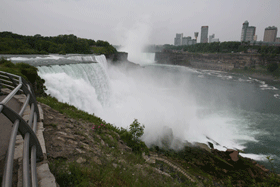
The Boundary waters treaty centennial was held at Niagra falls. (Photo: Dave Miller / International Joint Commission)
YOUNG: The U.S. and Canada just marked a century of cooperative conservation: the hundredth anniversary of the Boundary Waters Treaty. The treaty guides management of the Great Lakes, which contain one-fifth of the world's fresh surface water. And the anniversary comes just as that treaty is being re-negotiated to better respond to new challenges like climate change and invasive species.
Dr. John Gannon is senior scientist for the International Joint Commission that advises both countries on the Lakes. Gannon says the Boundary Waters Treaty was the world’s first environmental agreement between two nations. And it came at a time when environmental issues were nearly unheard of.
GANNON: Back in 1900 it was kind of the peak of cholera and typhoid fever epidemics. Folks thought that the Great Lakes were so large they couldn’t be polluted so the intakes for drinking water were very close to the untreated sewage outfalls, so that was a huge problem in 1900. And at the same time, hydropower was starting to be developed on the Niagara River and so there were some conflicts between, of course, Great Britain on behalf of the dominion of Canada and the United States at times. So both water quantity and water quality issues were in conflict at that time that spurred the negotiations for the Boundary Waters Treaty.
YOUNG: Interesting. So it was initially driven primarily by public health aspects of dealing with sewage and also this hydropower thing. How have the concerns evolved over time?
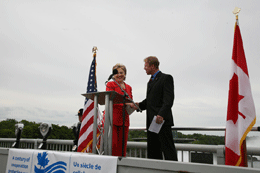
Secretary of State Hillary Clinton announced the United States will update treaty. (Photo: Dave Miller / International Joint Commission)
YOUNG: Now there are a lot of thirsty states in the arid regions of the country who look up at all that yummy fresh water in the Great Lakes and say “hey, if we had a long enough straw, we could get some of that.” What’s the status of that kind of thinking? Has that been nipped in the bud or are there still projects afoot that might draw down water from the Great Lakes and export it?

The Boundary waters treaty centennial was held at Niagra falls. (Photo: Dave Miller / International Joint Commission)
YOUNG: Now you’ve been working on this for quite a while now. Compare say the Lake Erie you saw in the 60s to the lake you see today.
GANNON: Oh, it’s better. There’s no question about that. What I like to tell the public is we’ve got kinda of this mix of positive and negative things going on all at once. So back then the lake sturgeon was almost completely gone. The walleye population was extremely depressed. Bald eagles weren’t reproducing. And so today we’ve got recovery of lake sturgeon. Lake whitefish are making a comeback. The walleye population is in much better shape than it was back then. Bald eagles are nesting on the shoreline throughout the lake so we’ve got a lot of these very, very positive things that are going on. But then yet the zebra mussel came in and we’ve got lots more upsets in the system going on. And actually, I’ve worked on the Great Lakes since 1966, when I was a graduate student and I never thought I’d ever see in my lifetime some of these bad algae and weed problems that we saw in the 60s come back in Lake Erie today. So, we can’t let our guard down and that’s the importance I think of the Great Lakes Water Quality Agreement and this recent announcement that the governments are updating it.
YOUNG: Dr. John Gannon is senior scientist at the International Joint Commission working to make sure that the Great Lakes stay that way – great. Thanks very much for your time.
GANNON: Thank you.
[MUSIC: Brian Henke “Great Lakes” from So Many Waters (VisionQuest Records 1997)]
CURWOOD: Just ahead: the tale of some unsung heroes of the environmental movement – the Coast Guard Service. Stay with us on Living on Earth.
Related links:
- Learn more about The Boundary Waters Treaty.
- Click here for more on the international Great Lakes water quality agreement.
[MUSIC: Christian McBride: “Pursuit Of Peace” from Kind Of Brown (Mack Avenue 2009)]
Note on Emerging Science
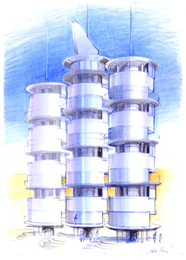
YOUNG: It’s Living on Earth. I’m Jeff Young.
CURWOOD: And I’m Steve Curwood.
Coming up – today’s birders resurrect the past to trace changing migration patterns. But first, this note on emerging science from Annie Glausser.
GLAUSSER: Go for a run during the hot summer months and chances are you’ll finish covered in salty, sticky sweat. The driving force behind the drips—humidity.
Instead of griping about the sticky weather, researchers in Germany want to harness it. They’ve designed a tower-like device that pulls drinking water right out of humid air. The key to its design is hygroscopic brine—a saline solution that dribbles down the tower, much like sweat rolls down our faces. As the salty brine trickles down the tower, it absorbs moisture from the air.
The diluted brine is sucked up into a ground-level tank. The tank, using solar energy, boils the brine so that the fresh water evaporates, condenses, and can be whisked away down a separate channel. The re-concentrated brine is then pumped back to the top of the tower and the cycle repeats.
Because the tower relies on solar cells, the design is completely self-sustaining—an important feature for areas where there’s little or no electricity. The device could be especially useful for places where lakes and rivers are scarce yet humidity is high.
Researchers hope that if their demonstration facility is successful, each teaspoon drawn from the air and tucked away in the tower’s tank could one day add up to a healthy water supply for communities.
So when the sweat clings to you this summer, just think: in this weather, you could be squeezing out drinking water.
That’s this week’s note on emerging science. I’m Annie Glausser.
Related link:
To learn more about the new design, click here.
Duck-Scrubbing Heroes
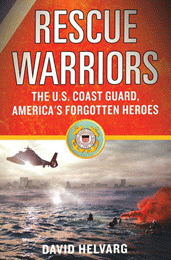
YOUNG: We all know the U.S. Coast Guard for their daring rescues at sea and the watchful eye they keep on our shores. But a new book chronicles the important and often- overlooked role the Guard plays in protecting our environment.
Ocean conservationist David Helvarg spent years following the Coasties from the hurricane wreckage of Louisiana to an oil spill in San Francisco Bay. His book is called "Rescue Warriors: The U.S. Coast Guard, America's Forgotten Heroes." And Helvarg argues that the Coast Guard is actually the country's oldest environmental agency.
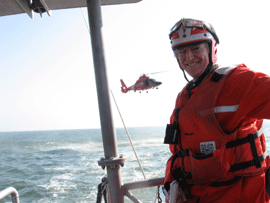
Author David Helvarg on assignment with the Coast Guard.
YOUNG: And one of their early heroes that you write about was this guy Mike Healy who has this great nickname I love “Hell Roarin’ Mike Healy.”
HELVARG: He was a very rough and tumble character and he and the Bear, which was his cutter, they saved whalers who were stranded in the ice. At one point when the whaling and the sealing was impacting native Alaskans food sources, he sailed the Bear over to Siberia and bought a herd of reindeer. They dragged them up onto the cutter and brought them back to Alaska and that was the beginning of reindeer herding. Mike Healy was actually African-American, but at the time he had to pass for white in order to have command of the Coast Guard. He was also hated by both the seal poachers and the temperance societies because he was well known hard drinker in all the bars up and down the west coast.
YOUNG: As I understand it from your book that their work in the early Alaskan frontier really influenced a lot of the later environmental items that they would take on as their duty.

A C-130 deploys in the Aleutians to watch over the Alaska fishing fleet.(Photo: David Helvarg)
YOUNG: You wrote about a big bust of fishery pirates that happened, when is this, the late 80’s, early 90’s. They were chasing down these Taiwanese salmon fisheries.
HELVARG: Yeah, late 80’s, early 90’s in the North Pacific there was a whole legal drift net fisheries over a thousand boats from Asia that were laying out these walls of death, these monofilament nets that could stretch thirty miles in length, killing thousands of dolphins and small whales and sea birds. And within these fleet there was a small pirate operation, about ten percent of them were taking salmon at sea. And there was a treaty between Japan, the U.S., Canada and Russia that these salmon should only be caught when they returned to their home rivers. They set up a sting and they went out to sea.

Enlisted training in Cape May, New Jersey. (Photo: David Helvarg)
YOUNG: You know this is amazing work they do. They’re police on the high seas. They do these amazing rescues. They’re protecting our natural resources. And yet, the Coast Guard – it’s like they’re the Rodney Dangerfield of the military. They just don’t get respect.
HELVARG: It’s funny. I’ve talked to a lot of young coasties who say, “you know, I want to serve my country, but I want to be in a service that saves lives rather than takes them.” And they do, they respond to 125 distress signals every day. They save fifteen people on average every day.
YOUNG: Wow.
HELVARG: And they also do the resource protection, oil spill response. But the oil spill response people are often to referred to in the service as duck scrubbers and the fisheries guys as fish huggers. Which seems unfair ‘cause they don’t call the maritime safety and security teams, they don’t call them gun huggers.

HELVARG: Yeah. They went in and they saved over 33,000 people in the first week after Katrina when much of the rest of the federal government was absent without leave. It was the coasties and the Louisiana Fish and Game who were out there pulling people off of rooftops and getting people out of flooded areas and to safety. When I was down there it reminded me of a lot of war zones I’ve been in with maybe fewer casualties, about 1,600 deaths, but far wider destruction. And the Coast Guard does what it does every hurricane season. They move their people out of the way of the approaching storm, just positioning them strategically around it, then surge back in afterwards.
YOUNG: But you also write about another Coast Guard mission that in your opinion did not go so well. And that was when a container ship spilled its bunker fuel in the San Francisco Bay. And that’s basically your backyard.
HELVARG: Yeah, I literally had oiled and dead ducks and wildlife washing up behind my townhouse in the East Bay. And the Coast Guard response was not good, you know. That morning that the Cosco Busan hit the bridge and spilled 53,000 gallons of bunker fuel which is like the dregs of the petroleum process. There’s nothing you can refine after bunker fuel other than roofing tar. And Admiral Bone who came from a safety and environmental background was telling me that morning that because of the heavy emphasis on security since 9/11 that the Coast Guard’s been losing some core competencies in safety and stewardship, environmental protection.
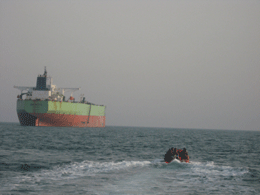
The Coast Guard inspects an oil tanker off the coast of Iraq. (Photo: David Helvarg)
HELVARG: Yeah, and I suspect that had it been a terrorist who had blown up that ship their MSST teams, their anti terrorist maritime security and safety teams would have been on it within minutes. There’s been a huge expansion of funding since 9/11 but almost all of it on the security side. And we haven’t seen similar growth in terms of ship safety, although the global shipping fleet is expanding or maritime stewardship, although we’re seeing the collapse of marine wildlife and food security with the loss of fisheries. You know, we’re no longer in a world in which we can respond to all crisis with guns. We have to be able to respond to an unknowable range of threats in a world that’s two-thirds salt water. And to me that response is best done by the well-trained gals and guys of the Coast Guard
YOUNG: David Helvarg founded the coastal conservation group Blue Frontier Campaign, and his new book is called “Rescue Warriors: The U.S. Coast Guard: Americas Forgotten Heroes. David, thanks very much.
HELVARG: Thank you.
[MUSIC: James Horner “Coast Guard Rescue” from the Perfect Storm Soundtrack (Sony Classical 2000)]
Related links:
- Click here to find out more about David Helvarg’s book, “Rescue Warriors.”
- Blue Frontier Campaign
Bird Lovers Build Bird Database

A wood duck and its reflection. (Photo: Ken Pauley)
CURWOOD: Birders have a long history of helping scientists. It's so long, in fact, that many records of their sightings now exist only as dusty cards tucked away in basements.
But one current effort has volunteers organizing bird observations from the 19th century to make them accessible. Amy Mayer visited the home of a volunteer in Acton, Massachusetts and has our story.
MAYER: The living room in Ken Pauley's suburban Boston home has windows on three sides. He keeps binoculars handy—to watch the geese on the pond, the hummingbirds at the feeders and the red-winged blackbirds landing on the closest tree.

The pond outside Ken Pauley’s Massachusetts home. (Photo: Ken Pauley)
[BIRD SOUNDS AND WALKING SOUNDS]
MAYER: Pauley points to the five nesting boxes he maintains for the ducks and the native plants that will create a meadow as they grow all summer. The mini conservation area on his 10 acres is rich with wild blueberry and azalea bushes and the cacophony of birdsongs.
[WETLAND SOUNDS]
PAULEY: That's a red-winged blackbird.
MAYER: Pauley began birding as a child in the Blue Hills just outside Boston and quickly befriended adult birders, who took him further afield. When he was twelve or thirteen, a friend invited him to go birding with a legendary pair.
PAULEY: So we jumped in his car, drove out to Ipswich River Valley Sanctuary and met the two guys. One was a white haired gentleman, another guy was a Brit. And the British fellow was Carl Fischer, quite an ornithologist in England. And the other fellow was Roger Tory Peterson.

(Courtesy of Houghton Mifflin Books)
PAULEY: We were walking along and Roger and I would just be walking and we’d stop and say, "black throated green" just by songs, and I'd say, yellow warbler and we would be just calling out because of the sounds. So for about three weekends I birded with Roger and Carl Fischer and Arthur Katz and it was a phenomenal experience because talk about, you know, people dedicated to ornithology. And of course to be birding with the author of the book that I’ve got in my hand was a great thrill.
MAYER: Pauley's passion for birding folded into his 43-year career as an educator at Boston's Museum of Science. He even leads safaris in Tanzania. Now retired, he brings his love of birds inside, too.
PAULEY: Now I have to log in, so I use my email address …
MAYER: Pauley sits at a small desk beside a picture window and enters the website for the North American Bird Phenology Program. It's a project sponsored by the U.S. Geological Survey to make six million cards useful. The cards document sightings from volunteer birders between 1880 and 1970. Pauley squints at the jpeg image that appears on the screen.
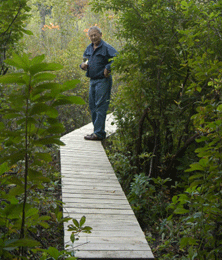
Bird enthusiast Ken Pauley. (Photo: Lucy Kirshner)
MAYER: The cards contain the bird species, location, dates and observer's name. Pauley says he's probably transcribed about 60 cards. That's part of the 70,000 cards documented so far by volunteers across the country. They rely on another group of bird lovers who go the USGS office in Laurel, Maryland six days a week to scan them in. USGS biologist Jessica Zelt coordinates the program.
ZELT: We've basically pulled all these cards out of storage; they've been stored for about 40 years in basements and attics and storage facilities and we're finally getting the recognition of how important these cards are; so we were able to pull them out and we're in the process now of digitizing them.
MAYER: Most of the birders were trained naturalists and scientists. Their observations tell the story of changing habitats and migration patterns.
ZELT: I have here another card, which was on the ivory billed woodpecker. It was in Jane Green Swamp, Florida, and it says here that Henry Redding saw four in January of 1923, and that was recorded in December…

(Photo: Ken Pauley)
MAYER: And there are introduced species seen as exotic a hundred years ago that are now familiar, such as starlings and house sparrows. Habitats also change. Cardinals rarely lived in New England in the mid-20th century, but now they're permanent residents here. Zelt says the data from the cards can help quantify these types of changes. And she's collecting records kept by researchers since 1970 to create a 120-year dataset that she says,
ZELT: Really could show us a lot about what’s happening with bird migration and climate change and what the effect is of climate change on these birds, on a nation-wide scale.
MAYER: While Pauley is interested in the science—and happy to be helping with it—when he's transcribing, he's got his eye out for his boyhood heroes.

Ken Pauley checks an owl house at his home in Acton, Massachusetts. (Photo: Lucy Kirshner)
MAYER: Even if it doesn't, Pauley enjoys being among the volunteers making this vast information accessible to researchers.
For Living on Earth, I'm Amy Mayer in Acton, Massachusetts.
[MUSIC: Dapp Theory “Bird Calls” from Layers Of Chance (ObliqSound 2008)]
Related links:
- Ken Pauley’s website
- The North American Bird Phenology program website
YOUNG: On the next Living on Earth: in the wake of the 9/11 attacks, the world went on guard against nuclear terrorism. So how are we doing?
ALLISON: On the current trajectory, terrorists will successfully conduct a nuclear or biological terrorist attack somewhere in the world in the next five years.
YOUNG: Why we’re less safe now than we were just five years ago - next time on Living on Earth.
[WOODPECKER SOUNDS]
CURWOOD: We leave you this week in the company of a three-toed woodpecker.
[WOODPECKER SOUNDS]
CURWOOD: Now, most woodpeckers have four toes on each foot, but the three-toed and black-backed woodpeckers are unusual, with only three. These birds prefer dead trees in coniferous forests, and have a broad range across North America.
Martyn Stewart recorded the drums and squeaks of this American Three-toed woodpecker for the cd “The Owl and the Woodpecker.”
[BIRD SOUNDS]
YOUNG: Living on Earth is produced by the World Media Foundation. Our crew includes Bobby Bascomb, Eileen Bolinsky, Bruce Gellerman, Ingrid Lobet, Helen Palmer, Jessica Ilyse Smith, Ike Sriskandarajah, and Mitra Taj, with help from Sarah Calkins, Marilyn Govoni, and Sammy Souza.
CURWOOD: Our interns are Annie Glausser, and Lisa Song. Jeff Turton is our technical director. Alison Lirish Dean composed our themes. You can find us anytime at loe.org.
I’m Steve Curwood.
YOUNG: And I’m Jeff Young. Thanks for listening.
[All Living On Earth music themes composed by Allison Lirish Dean (2001)]
Living on Earth wants to hear from you!
Living on Earth
62 Calef Highway, Suite 212
Lee, NH 03861
Telephone: 617-287-4121
E-mail: comments@loe.org
Newsletter [Click here]
Donate to Living on Earth!
Living on Earth is an independent media program and relies entirely on contributions from listeners and institutions supporting public service. Please donate now to preserve an independent environmental voice.
NewsletterLiving on Earth offers a weekly delivery of the show's rundown to your mailbox. Sign up for our newsletter today!
 Sailors For The Sea: Be the change you want to sea.
Sailors For The Sea: Be the change you want to sea.
 The Grantham Foundation for the Protection of the Environment: Committed to protecting and improving the health of the global environment.
The Grantham Foundation for the Protection of the Environment: Committed to protecting and improving the health of the global environment.
 Contribute to Living on Earth and receive, as our gift to you, an archival print of one of Mark Seth Lender's extraordinary wildlife photographs. Follow the link to see Mark's current collection of photographs.
Contribute to Living on Earth and receive, as our gift to you, an archival print of one of Mark Seth Lender's extraordinary wildlife photographs. Follow the link to see Mark's current collection of photographs.
 Buy a signed copy of Mark Seth Lender's book Smeagull the Seagull & support Living on Earth
Buy a signed copy of Mark Seth Lender's book Smeagull the Seagull & support Living on Earth

